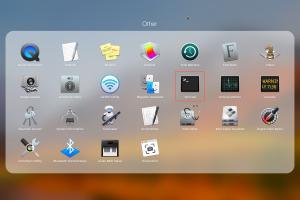3 Simple Methods to Open a Terminal Window on Your Mac

-
Quick Links:
- Method 1: Using Spotlight Search
- Method 2: Accessing Terminal Through Finder
- Method 3: Using Launchpad
- Case Studies
- Expert Insights
- FAQs
Method 1: Using Spotlight Search
Spotlight Search is a powerful tool on your Mac that allows you to quickly find files, applications, and even perform calculations. Here's how you can use it to open the Terminal:
- Press Command (⌘) + Spacebar to bring up the Spotlight Search.
- Type Terminal into the search bar.
- Once Terminal appears in the results, press Return to open it.
This method is ideal for users who want a quick and efficient way to access the Terminal.
Method 2: Accessing Terminal Through Finder
If you prefer a more visual approach, you can open the Terminal from the Finder:
- Click on the Finder icon in your dock.
- From the menu bar, click on Go and select Utilities.
- In the Utilities folder, double-click on Terminal.
This method is straightforward and perfect for users who might not be familiar with keyboard shortcuts.
Method 3: Using Launchpad
Launchpad provides a way to access all your applications in one place. Here’s how to open Terminal using Launchpad:
- Click on the Launchpad icon in your dock.
- Type Terminal in the search field at the top.
- Click on the Terminal icon to open it.
Using Launchpad is excellent for users who enjoy a graphical interface and want to explore other applications on their Mac.
Case Studies
Understanding how different users utilize Terminal can provide insights into its functionality:
- Case Study 1: Graphic designers often use Terminal to manage file permissions swiftly, saving them valuable time during projects.
- Case Study 2: Software developers rely on Terminal for deploying applications and automating scripts, showcasing its essential role in programming environments.
- Case Study 3: System administrators use Terminal for network configurations and troubleshooting, illustrating the tool's importance in maintaining systems.
Expert Insights
Experts recommend familiarizing yourself with Terminal commands, as it offers more control and flexibility than standard graphical interfaces. Here are some insights:
- Command Line Efficiency: Learning basic commands can significantly speed up your workflow.
- Customization: Terminal allows users to customize their experience, from themes to shortcuts, enhancing usability.
- Learning Resources: Websites like Codecademy offer courses to help users become proficient in command-line operations.
FAQs
- Q1: What is Terminal used for on a Mac?
A1: Terminal is used to interact with the operating system through command-line inputs, allowing for advanced tasks and automation. - Q2: Is it safe to use Terminal?
A2: Yes, but you should only execute commands you understand, as incorrect commands can affect system performance. - Q3: Can I customize Terminal?
A3: Yes, you can change the appearance and settings in the Terminal preferences. - Q4: What are some basic commands I should know?
A4: Common commands include `ls` (list files), `cd` (change directory), and `cp` (copy files). - Q5: How do I close the Terminal window?
A5: You can close it by typing `exit` or clicking the red close button in the window. - Q6: Can I open multiple Terminal windows?
A6: Yes, you can open multiple Terminal windows or tabs for multitasking. - Q7: What is the difference between Terminal and other command-line interfaces?
A7: Terminal is specific to macOS, while other command-line interfaces may vary by operating system (e.g., Command Prompt for Windows). - Q8: Is Terminal available on all Mac models?
A8: Yes, Terminal is included with all macOS versions on any Mac model. - Q9: Can I run scripts in Terminal?
A9: Yes, you can run scripts and automate tasks using Terminal. - Q10: How can I learn more about using Terminal?
A10: You can find tutorials online, including official Apple documentation and various coding websites.
Random Reads
- How to remove scratch on glass cooktops
- How to remove shortcut virus
- Remove spaces excel
- Remove super glue
- How to remove permanent hair dye from carpets
- How to remove knockouts electrical box
- How to use gps on android
- How to use google translate
- Mastering password security ultimate guide
- How to turn on push notifications iphone ipad